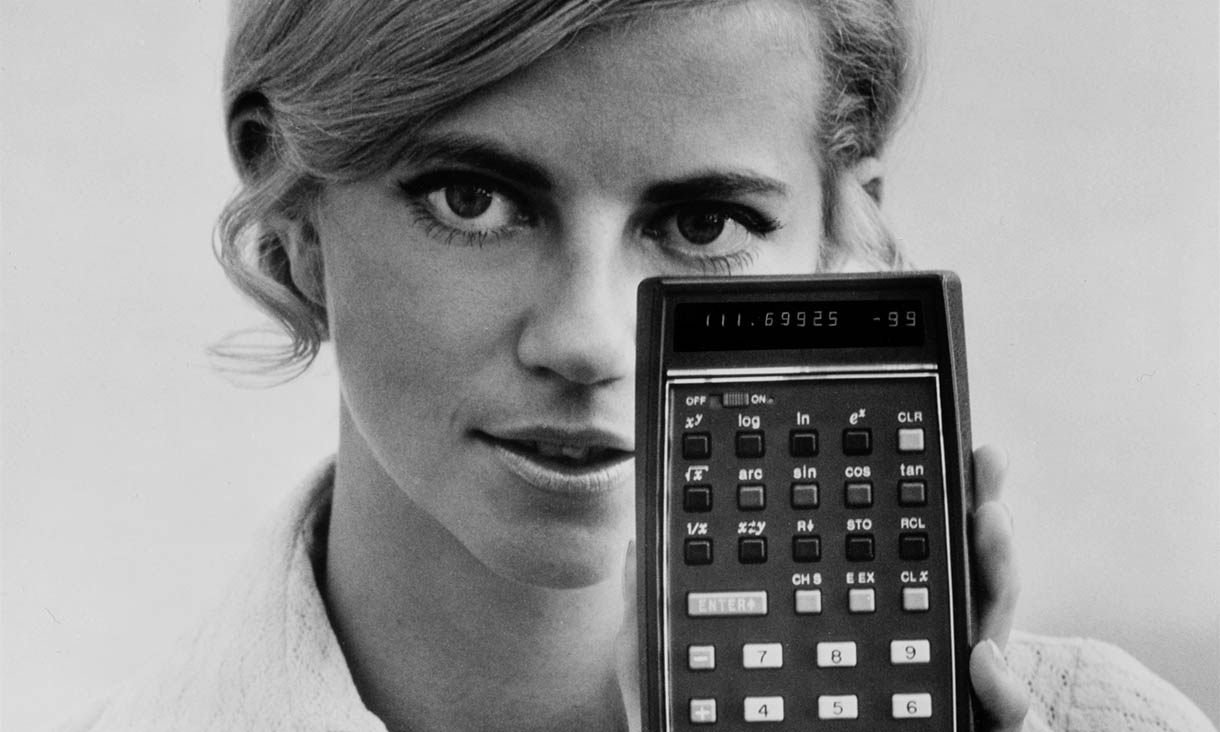The HP-35
Consumer Electronics, an Origin Story
Sometime in late 1971, Peter Nelson, from Hewlett-Packard’s Corporate Relations Department in Palo Alto, enlisted Karen Cambria, from the Automatic Measurement Division (conveniently, in the same building), to pose with their new electronic device, a scientific calculator they named the HP-35. Norton Pearl took several photos of Karen with the calculator and it was this photo that ended up in the press kit.
HP didn’t typically employ beautiful models—even if they were employees—to sell their products. For their typical customers—corporations, hospitals, educational institutions and government agencies—technical ads in trade journals or displays at trade shows were always more than sufficient, but for their new calculator it was clear they were going to have to try something different. The economic downturn of the early 1970s meant that their normal customers weren’t buying new electronic equipment and, to make matters worse, a market research study concluded that—regardless of the economy—very few would buy what was seen as an expensive slide rule replacement.
So HP’s Marketing Department decided to do something it had never done before. Instead of advertising in engineering and scientific journals, they would place ads in magazines like Esquire or Scientific American and sell the HP-35 by mail-order direct to the customer. That’s where the photo of Karen comes in.
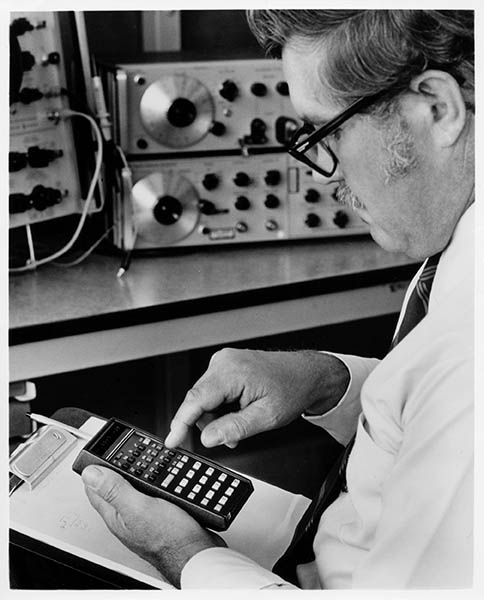
I—The Origin of the Origin Story.
It’s likely you already know this story: at the height of the Depression, Bill Hewlett and Dave Packard, both recent Stanford graduates, decided to go into business together. They found a cheap rental in Palo Alto, just blocks from the Stanford campus, and in the garage out back—now considered ground-zero of Silicon Valley—they began the Hewlett-Packard company. Their first product, an audio oscillator that used a light bulb as part of the circuitry, was purchased by Walt Disney to help with the sound on his new project—the film Fantasia.
The oscillator was followed over the years by nearly every imaginable piece of scientific test equipment—things like signal generators, frequency counters, Q-meters (?), pulse generators, wave analyzers, voltmeters and oscilloscopes. Eventually HP was offering so many products that it took a four-pound, nearly 600-page catalog to describe them all. The Palo Alto garage became facilities scattered throughout the Valley, then the rest of America, and finally Europe and Japan. By the mid-1960s they were a Fortune 500 company with 9000 employees.
Tom Osborne, a Berkeley-trained electrical engineer, wasn’t one of those 9000 employees. In his Bay-area apartment, he had built a floating-point electronic calculator he called the Green Machine (after the color of the automotive touch-up paint he used on the balsa wood case). He tried shopping it around but no one was interested until he showed it to HP in June, 1965. Bill Hewlett asked “can it do transcendentals [sine, cosine, tangent, etc]?” Osborne’s Frankenmachine couldn’t, but he replied “Sure, why not?” Hewlett was sufficiently impressed and convinced Osborne to stay on for six weeks as a consultant to see if he could turn his device into a proper calculator.
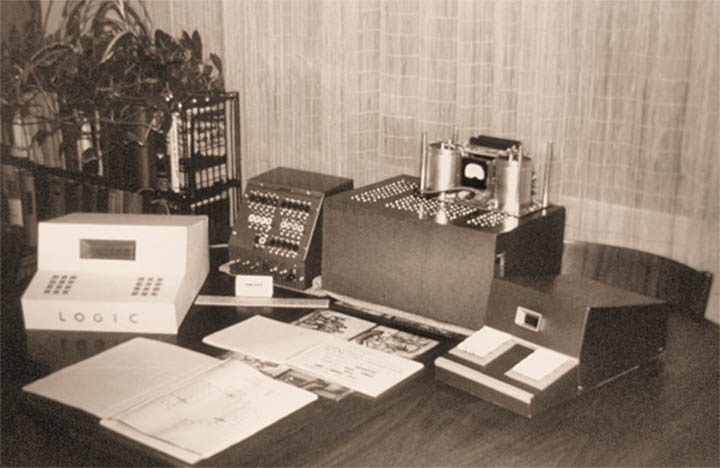
Initially Osborne had some difficulty explaining his processes (“I didn’t even have names for most of them,” he said), but eventually he and the HP engineer Dave Cochran (who was previously working on oscillators and claimed he didn’t even know what an algorithm was) managed to code into an inductive ROM not only basic floating-point arithmetic, but logarithmic and transcendental math as well. The engineers also decided to made the machine keystroke-programmable, a feature Osborne had never envisioned. At the time HP was new to digital design—their first computer, the mini frig-sized 2116A, was released in 1966—and everything about the calculator project taxed their engineering and manufacturing abilities. “I was barely able to stay ahead of the alligators on my tail,” Osborne recalled. His six weeks became six months, then a year, and then another, but, finally, in early 1968, they had finished the 40-pound, typewriter-sized 9100A Computing Calculator.
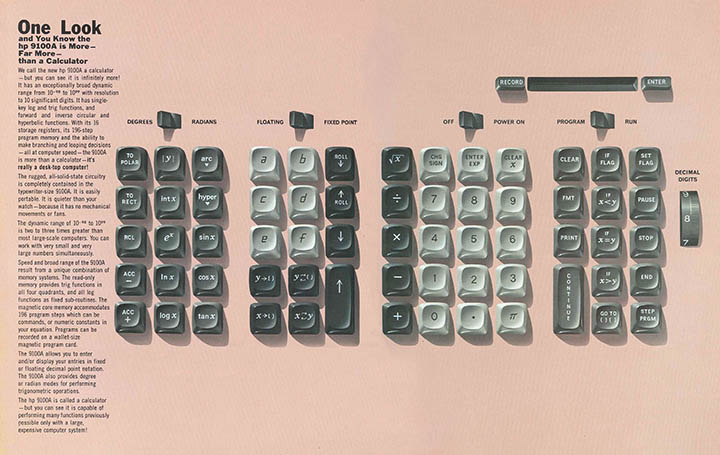
The 9100 was introduced at the New York IEEE show on March 11th, 1968. It filled a gap in the market between simple adding machines and complicated mainframes and was, in many ways, the first personal computer. Steve Jobs (yeah, that Steve Jobs) remembered the 9100 as the first desktop computer he ever saw.
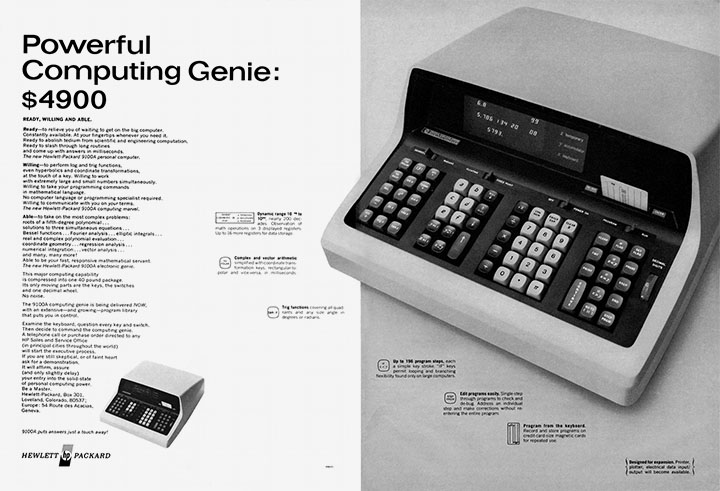
While the Loveland (Colorado) Division was busy building 9100s and designing the next generation of desktop calculators, HP Labs in Palo Alto began working on an interesting fork in the calculator project.
II—The Shirt-Pocket Brief.
In what has to be one of the most famous design briefs in electronics history, Bill Hewlett asked Osborne and Cochran to shrink the 9100. “I want it to be a tenth of the volume, ten times as fast and cost a tenth as much.” Where Hewlett wanted the 9100 to fit in his secretary’s desk return, he wanted this new device to fit in his shirt pocket.
At the time it seemed like an impossible request, but Hewlett didn’t let the idea go. Cochran, who for a time lived across the street from Hewlett, would occasionally give him a ride to work. “I was a captive audience,” he said, “and Bill would always ask ‘how are you coming along with that calculator?’ ” “Well, I’m working on it,” was all Cochran could answer. Osborne thought that it might be possible to shrink the 9100 into something that would fit in a briefcase, but not something that would fit in a pocket. For that Hewlett was just going to have to wait.
Here’s some calculator history: there was the abacus, then the slide rule, then the adding machine (both mechanical and electric) and, in 1961, the first all-electronic calculator, the eight-tube ANITA Mk VII. By this time, however, the vacuum tube was already being replaced by the much smaller, more energy efficient and less expensive transistor.
The first all-transistor—or solid state—calculator, the Friden EC-130, was introduced in 1963. Two years later, Wang introduced the LOCI-2, the first scientific programmable calculator, and in 1968—as you already know—HP released the 9100A. All of these machines used discrete components: individual transistors and diodes soldered onto multiple circuit boards; acoustic relay or magnetic core memory and nixie tube or CRT displays. By this time, however, the transistor was being replaced by the integrated circuit.
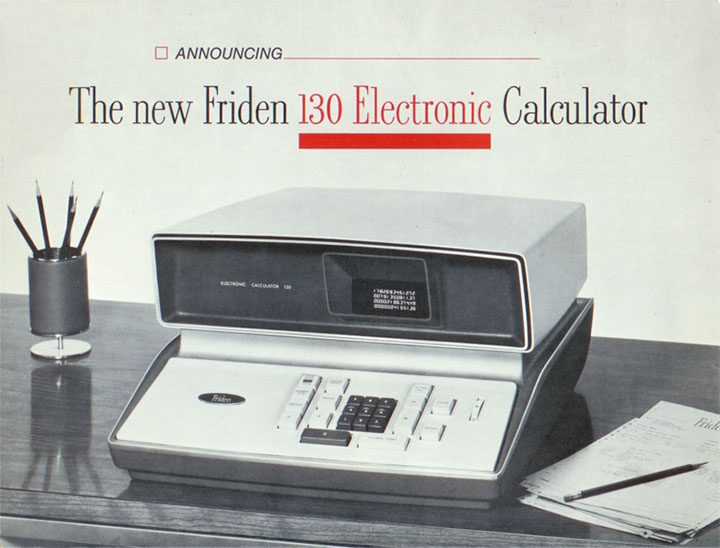
The integrated circuit—multiple transistors etched onto a single silicon chip—dramatically changed the industry (actually, that’s somewhat understating it, the IC dramatically changed the world, and even that is probably an understatement). By the early 1970s the semiconductor manufacturers—Fairchild, Mostek, Rockwell, Texas Instruments and a new start-up, Intel—began designing and selling general-purpose calculator chips or chip sets. In 1971, Sharp introduced the first portable calculator, the four-chip EL-8, and Busicom introduced the first truly handheld calculator, the one-chip Handy LE. Soon the market was flooded with inexpensive, mostly Japanese, four-function calculators.
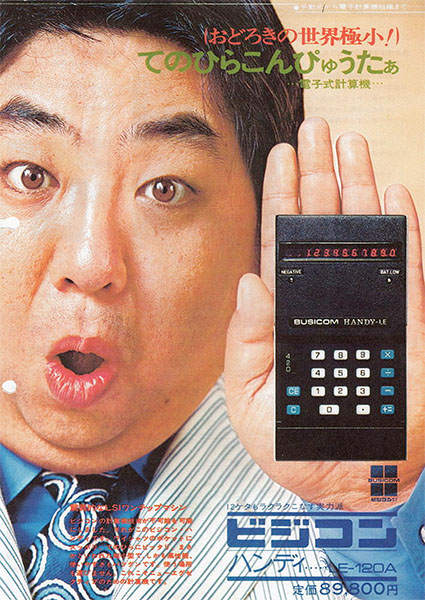
Osborne realized that these new chips were now small enough to realize Hewlett’s calculator. Cochran found a four-function serial-bit chip set by Fairchild that he thought he could use. He asked if they would make some modifications, but Fairchild, then the largest semiconductor manufacturer in the world, wasn’t interested. They did, however, tell him that he could use the design. After all, they had gotten it from Sweda, a cash register company.
III—Designing the Electronic slide rule.
Work on the shirt pocket calculator began informally in November, 1970, using an under-the-table budget. It soon became clear that the entire project was going to cost around a million dollars. “That’s when a million dollars was really a million dollars,” said one engineer, and that was a problem for Hewlett.
The sluggish, inflationary economy of the early 1970s hadn’t been kind to HP. After five years of steady growth profits dropped 11% in 1970 and the next year the company instituted a wage freeze and, for the first time since the end of WWII, staff layoffs. After he heard the price tag for his calculator, Hewlett felt he owed shareholders due diligence and asked the Stanford Research Institute to do a market survey. Their report suggested that, considering the market for cheap four-function calculators and 20-dollar slide rules, they couldn’t predict how many would buy an expensive scientific calculator, but their conclusion was clear: “we don’t recommend that you go ahead with this.” Osborne recalls telling Hewlett “I know if we come in [with a scientific calculator] you’ve got the market from there on up, but if you go down, its gonna be competitive, competitive, competitive.” Eventually Hewlett, despite the SRI report, decided he wanted one and thought his engineers should have one as well. On February 2nd, 1971—Groundhog Day—he gave the official go-ahead.
Based on the borrowed Fairchild/Sweda design, the calculator would have a control and timing chip, an arithmetic and register chip, and three 2560-bit (bit, not byte) ROMS. Cochran—who, after the 9100, now knew all about algorithms—was responsable for the logic. For the log and exponential functions he used pseudo division and multiplication algorithms from Briggs’ 1624 Arithmetica Logarithmica. For the transcendental functions he used Volder’s CORDIC algorithm, originally developed for B-58 navigation. Other functions required still other algorithms.
Instead of building and rebuilding breadboards, France Rode and Chung Tung coded Cochran’s algorithms entirely on a computer, a first for HP. The service routines eventually took up a third of the ROM, so it took them more than a little finessing to fit everything into the remaining 5140 bits (or 0.6 K). In fact, space became so tight that to add a single new instruction they had to remove another.
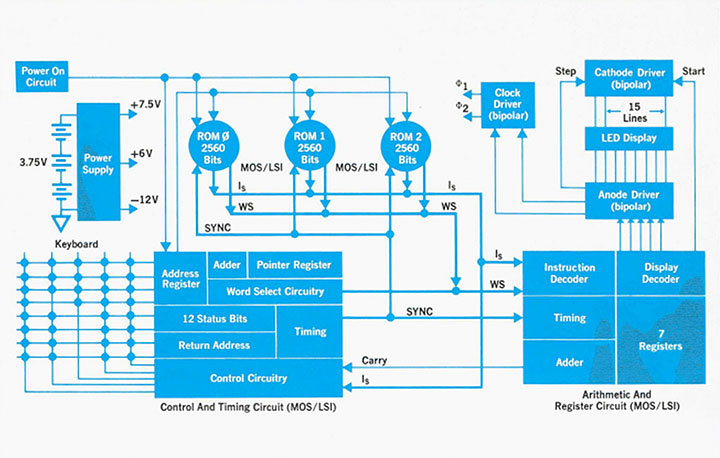
By the end of February HP began looking for companies to manufacture their chip set—five metal-oxide, large-scale chips with five or six-thousand transistors each. Although that seems quaint now (after all, my current phone has a single chip with 3.3 billion transistors), at the time it was pushing the limits of semiconductor fabrication. Several companies said the design would need more chips, or at the very least larger chips, but two, Mostek and American Microsystems (AMI), said they could manufacture the chip set to HP’s specs. Cochran and his team spent the rest of spring and summer developing the ROMs.
While Cochran was working on the logic, Osborne was working on the general design. “The project was just plain fun,” he said. “[I] spent a lot of time deciding whether the arithmetic keys should be on the right or the left and whether the + key should follow the convention of adding machines and be placed in the lower right corner, or whether it should be located where it is most convenient.” In fact, Osborne spent months obsessing over the design of the keyboard. He sketched out a concept “about the size of a Benson & Hedges cigarette pack,” and turned it over to the industrial design team.
Ed Liljenwall, who had been with HP for a decade, was used to designing an enclosure to fit around the electronics, but for this project he designed a case that the electronics would have to fit into. This outside-in design was a reversal for not only HP, but the entire industry. Liljenwall came up with a wedge-shaped case with a curved face and sides. He flared the edges, making the device look thinner than it really was, angled the display, making it visible both in the hand and on the desk, and specified a textured case to improve its grip. He even paid attention to the back, making the rubber feet serve as battery compartment latches. It was an elegant industrial design that the Japanese couldn’t match and one that would define the shape of a calculator for the next decade.
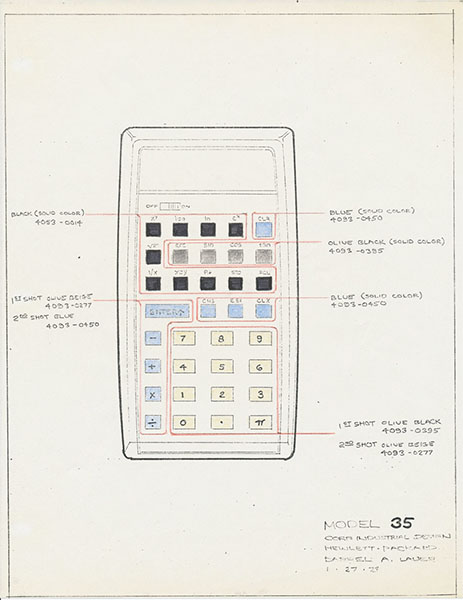
brown, tan and orange buttons. The final iteration had black, gray, blue and white buttons, which, perhaps not coincidently, were the colors of HP’s corporate logo
For the display, the engineers decided to use HP’s own LEDs. Unfortunately, at the time, HP Associates were offering them internally for five dollars apiece and the calculator needed 15 of them. When he heard this, Hewlett called and pressed the point: “Dave, how much to get LEDs down to three dollars apiece? Well, you can think about it; anytime tomorrow would be fine.” Eventually, by ordering 750,000 LEDs, Osborne was able to get the price down to a dollar each.
The final problem, a miniaturized power supply capable of powering the calculator for three hours, was solved by Chu Yen of HP Labs. To cut costs HP placed one of the largest battery orders that Union Carbide and General Electric ever received.
By July, 1971, the engineers had finalized the chip design with Mostek and AMI, by August they had put everything together and had a working device, and by November they were building prototypes at the Advanced Products Division in Cupertino. The entire project took 14 months, half of HP’s typical design cycle. When Hewlett received the very first prototype he simply said “It’s about time, I’ve been waiting for this.”
The calculator was finished, but the question remained: would anyone buy it?
IV—Market It And They Will Come, Or, Maybe Not.
Osborne had run an informal “name the baby” contest and had several pages of suggestions (Athena, the Math Marvel, et. al.), but when Hewlett saw the prototype he said the name would be the HP-35, after the device’s 35 keys. It didn’t matter that HP’s computerized inventory system only recognized four-digit names—the HP-35 it was.
HP typically priced their equipment at the cost of the material list × π (or in an especially competitive market, list × e) and the list for the calculator was adding up: the chip set cost more than 100 dollars, the display assembly around 20 dollars, and then there was an expensive plastic case, double-injected keys, gold-plated circuit boards and custom battery packs. The accountants came up with a price of 395 dollars—four times the cost of a Japanese four-function calculator and nearly 20 times the cost of a slide rule—and even at that price they figured they would have to sell 10,000 just to break even.
With a device, a name, and a price, the Marketing Department in Palo Alto got busy. HP had always sold their equipment through field agents (who were happy to take their 15% commission). This worked fine for their electroencephalographs or gas chromatographs, but was going to be a problem for a small device with a thin margin. So, in an unusual move, Marketing side-stepped much of their traditional sales network and sold the HP-35 direct by mail order through advertisements in newspapers and popular magazines. Even more unusual, they also decided to sell the HP-35 at retail. “The marketing director had to subscribe to Women’s Wear Daily to figure out how to sell it in department stores,” Cochran recalled. “We [had to worry about] sales per square foot on the first floor of Macy’s, vs. the second floor.” It was all completely new territory for the company.
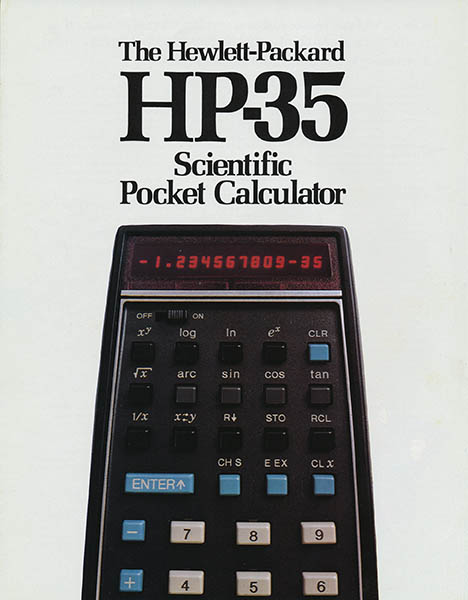
On January 4th, 1972, at a press conference at the St. Regis Hotel in New York, Hewlett finally announced the HP-35. If there was any doubt how well Hewlett’s expensive slide rule replacement was going to sell, it quickly evaporated. Every engineer, every scientist and every mathematician wanted one. Students were literally selling their cars to afford it. General Electric asked for a quote for 20,000 units. Soon HP couldn’t keep up with demand. They added a night shift in Cupertino, but there still was a waiting list. In all it took 18 months for them to catch up with the backlog of orders.
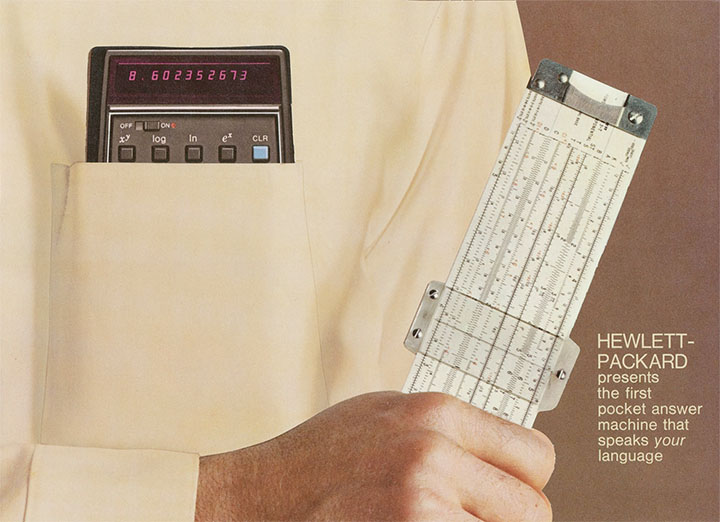
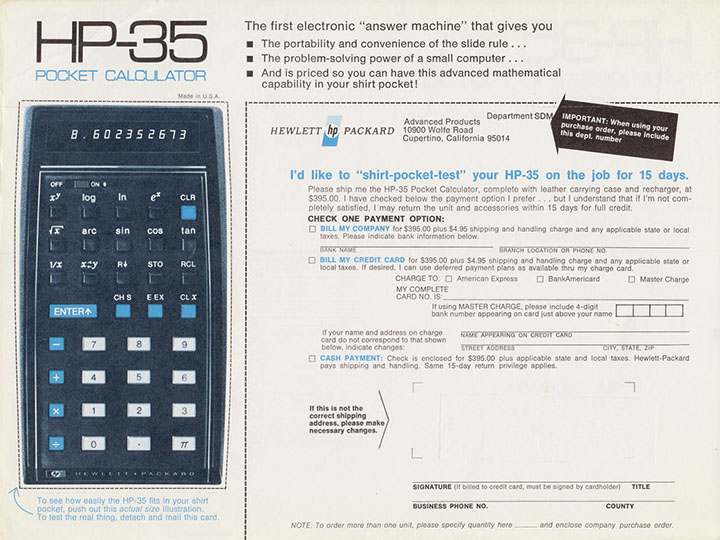
In the slim owner’s manual, they wrote that the HP-35 “[was] something only fictional heroes like James Bond, Walter Mitty or Dick Tracy are supposed to own,” but in reality they had created a device from the future—something that Captain Kirk of Star Trek was supposed to own. The calculator became much more than a slide rule replacement for engineers: climbers carried it to the top of Everest to do altitude calculations; Apollo astronauts used it in space to calculate re-entry coordinates and Nixon’s delegation, on their historic visit to China, even took a few along to demonstrate American ingenuity.
In all, 100,000 HP-35’s (or more than 10× their estimate) were sold in the first year—accounting for more than half of the company’s total profits—and nearly 350,000 were sold over its three-year lifespan.
It would be difficult to overestimate how disruptive the HP-35 was. As Lewis Terman stated when he named it an IEEE Milestone in 1997: “[it] accelerated the pace of technological change and revolutionized the engineering profession.” Only four years later the venerable firm of Keuffel & Esser manufactured their last slide rule.
The Regency TR-1 radio may have been the first commercial handheld electronic device, but it was the HP-35 that first truly presaged the future of consumer electronics. The combination of state-of-the art ICs (and later, microprocessors), close attention to programming and carefully considered industrial design served as the model for nearly every handheld device since; everything from Mattel Electronic Football (1977), to the Gameboy (1989), to the Palm Pilot (1997), to the Nokia 1100 (2003), to even your current face-recognizing iPhone.
V—Epilogue.
After the HP-35, Cochran became involved with employee recruitment and Osborne—still a consultant—continued to work on calculator designs, including what became his favorite project, the programmable HP-65.
HP designed and built their calculators in Cupertino until 1976, when the program was moved to the Corvallis (Oregon) Division. The 98-acre Cupertino campus continued to the the home of HP’s Personal Computer Division until they decamped to Palo Alto in 2010. Steve Jobs bought the property that summer and the site is now part of Apple’s new Pentagon-sized spaceship headquarters.
I have a last-generation HP-35, which, according to the serial number, was built in the second week of 1973. It was given to me by a friend who used it in the field when he was a surveyor and it shows: the silver bezel is worn, the face has the tell-tale crosshatch pattern of over-agressive cleaning, there is mildew (or something) in the battery compartment, the contacts are corroded, and the battery pack is, obviously, years beyond dead. I’m sure it has been decades since it was last used, but I plugged it into the wall, cycled the on/off switch a few times and there it was—a bright, red 0. The calculator is now 45 years old, but it still works.
Of course it still works.
—August 3rd, 2015. Updated May 2nd, 2018. Design
